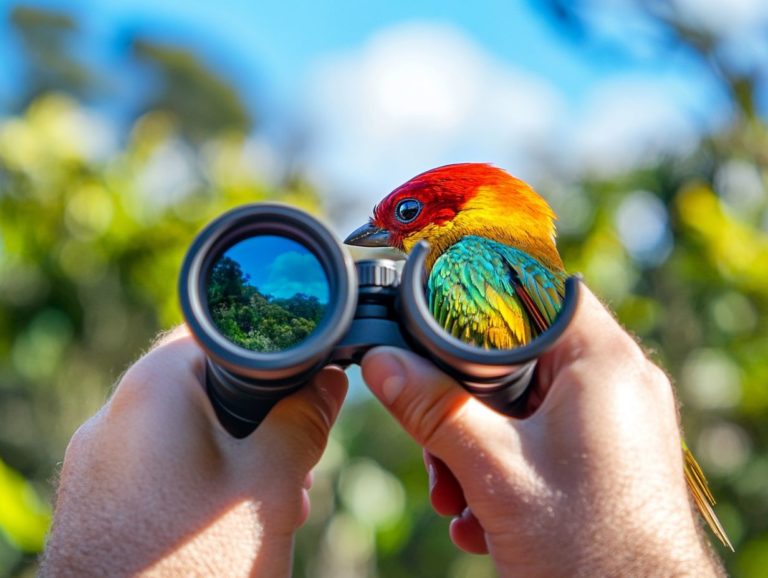Comparing Binoculars for Bird Watching vs. Astronomy
When you venture into the great outdoors or gaze at the night sky, the right pair of binoculars can truly transform your experience.
This guide will illuminate the essential features to consider, such as magnification and field of view, equipping you to select the perfect binoculars tailored to your needs.
You ll explore the best options for bird watching and astronomy, weighing their unique advantages and drawbacks.
Whether you’re a nature enthusiast or a stargazer, you’re bound to find exactly what you need for your outdoor adventures!
Contents
- Key Takeaways:
- Features to Consider in Binoculars
- Best Binoculars for Bird Watching
- Best Binoculars for Astronomy
- Comparing and Contrasting Birding and Astronomy Binoculars
- Frequently Asked Questions
- 1. What are the main differences between binoculars for bird watching and astronomy?
- 2. Can I use the same binoculars for both bird watching and astronomy?
- 3. Is image stabilization important for both bird watching and astronomy binoculars?
- 4. Are waterproof binoculars necessary for both bird watching and astronomy?
- 5. Which type of binoculars are more suitable for eyeglass wearers for both bird watching and astronomy?
- 6. Are there any specific features to look for when comparing binoculars for bird watching and astronomy?
Key Takeaways:

- When choosing binoculars for bird watching, consider a lower magnification and larger objective lens size for a wider field of view and better light gathering ability.
- For astronomy, higher magnification and larger objective lens size are necessary to view distant and faint celestial objects, with a narrower field of view and larger exit pupil for better optical performance and image clarity.
- While birding and astronomy binoculars may have some overlapping features, it is important to choose the right one for your specific activity to get the best viewing experience.
Overview of Uses and Differences
When exploring the great outdoors, you ll find that both birding and astronomy offer unique experiences that can be significantly enhanced with the right equipment specifically, binoculars.
These versatile tools give you the power to observe wildlife during the day or gaze at the mesmerizing night sky, making them critical for both outdoor enthusiasts and casual explorers.
For birdwatching, you ll want high-quality optics with a wide field of view to catch those quick-moving species. Features like waterproof and durability become invaluable when the weather decides to play tricks on you.
Choose binoculars with higher magnification and larger objective lenses for clearer, brighter views of distant wonders like star clusters and planets. This will enhance your stargazing experience.
Brands like Celestron and Steiner truly shine in catering to these distinct needs. They offer specialized models that prioritize optical clarity, build quality, and user comfort.
By selecting the right binoculars tailored to your activities, you ll unlock amazing adventures in both the vibrant wildlife and the starry universe above!
Features to Consider in Binoculars
Selecting the perfect binoculars for birding or astronomy can feel overwhelming, but understanding the essential features can significantly elevate your viewing experience.
Focus on key aspects such as magnification levels, objective lens size, eye relief, and the overall optical performance of the binoculars. Whether you lean towards premium brands like Celestron or more budget-friendly choices from Steiner, it s crucial to ensure that your binoculars are waterproof and lightweight.
This attention to detail will enhance both portability and convenience during your outdoor escapades, making them more enjoyable for outdoor enthusiasts.
Explore your options today and find the perfect pair of binoculars to elevate your outdoor experiences!
Magnification and Objective Lens Size
Magnification and objective lens size are crucial specifications that determine how effective binoculars will be for you, whether you’re birdwatching or stargazing. A higher magnification lets you see distant wildlife or celestial wonders clearly, while a larger objective lens size enhances light-gathering ability, making it easier to observe in low-light conditions.
For tracking fast-moving targets like wolves or swans, and for stargazers exploring the night sky, these features are essential for an exceptional viewing experience.
If you’re choosing binoculars, you’ll find that an 8x magnification paired with a 42mm objective lens provides the perfect balance. This combination offers stability and helps you quickly identify and follow the graceful movements of birds.
If you’re passionate about astronomy, you may prefer 10x or even 12x magnifications with larger lenses like 70mm or 80mm. These options let you capture intricate details of distant planets and star clusters, enhancing your stargazing experience.
Your choices reflect your unique viewing priorities. For quick observations in the field, you ll love the portability and ease of use. In darker, rural settings with minimal light pollution, you’ll benefit from enhanced detail and brightness, making your celestial explorations even more mesmerizing with the right equipment.
Field of View and Exit Pupil

The field of view and exit pupil are key technical aspects that significantly affect binocular performance in various environments, whether you’re tracking wildlife or stargazing.
A wider field of view allows you to quickly locate and follow moving targets, like eagles soaring or coyotes darting through a field. The exit pupil measurement indicates image brightness, especially in low-light settings, improving your overall experience while observing wildlife or stargazing.
For example, during early morning birdwatching, a larger exit pupil gives you the extra brightness needed to spot elusive species. Similarly, on clear evenings, a narrow field of view may complicate your attempts to scan the vast night sky efficiently.
Selecting equipment that optimally balances these features can significantly enhance your observational experience, ensuring clearer and more enjoyable sightings of both the natural world and the cosmos, whether for wildlife or stargazing.
Best Binoculars for Bird Watching
Choosing the right binoculars can elevate your wildlife observation. With the right pair, you can appreciate the intricate details and lively movements of birds in their natural habitats.
Consider renowned brands like Steiner, which offer user-friendly options that provide exceptional optical performance, a lightweight design, and waterproof features. These binoculars are perfect for various outdoor conditions, making them versatile for all types of users.
When selecting your top picks, look for models with adjustable magnification and excellent eye relief. These features are crafted for observing both stationary and moving targets. This thoughtful selection can transform every outing into a memorable adventure.
Discover the perfect binoculars for your next adventure!
Top Picks and Key Features
When it comes to bird watching, choosing the right binoculars enhances your experience. Look for sharp images and lightweight, waterproof designs.
Take the Celestron Nature DX, for instance. Its robust build and impressive clarity make it a favorite among beginners and seasoned observers alike. With a close-focus capability that lets you view subjects as near as 6.5 feet, it’s perfect for spotting near-ground birds.
Maven’s B1 Series stands out for its bright colors and clarity. If you need something portable without losing quality, consider compact models like the Vortex Diamondback. These designs strike a balance between weight and functionality, ideal for long treks through the woods.
Every binocular offers unique benefits for bird watchers. Choosing the right pair makes the adventure even more exciting!
Best Binoculars for Astronomy
For astronomy lovers, selecting the right binoculars is crucial. Enjoy the night sky clearly and precisely with the right tools.
High-power models from esteemed brands like Celestron deliver exceptional optical performance for observing celestial bodies and tracking moving objects. Their lightweight design and waterproof construction make them perfect companions for evenings spent under the stars, whether you’re focused on the moon or far-off galaxies.
When searching for binoculars for astronomy, the top contenders today offer exceptional optical quality and an unparalleled user experience. Look for models with impressive specifications, like high magnification and a wide field of view, to capture crisp images of planets and constellations. Renowned brands like Nikon and Canon consistently emerge in discussions about the best binoculars for astronomy due to their commitment to quality and performance.
Features such as fully multi-coated lenses and lightweight designs significantly enhance usability, allowing even novice stargazers to hold their binoculars comfortably for extended periods. Customer reviews often praise the ease of setup and user-friendly focus adjustment, making these models welcoming for beginners. Some options come equipped with protective rubber coatings and waterproofing for added durability.
So, whether you re mesmerized by the Milky Way or eager to explore neighboring planets, selecting the right binoculars can transform an ordinary night under the stars into an exhilarating journey through the cosmos.
Comparing and Contrasting Birding and Astronomy Binoculars
Comparing binoculars for bird watching and astronomy reveals different needs. For birding, comparing different types of binoculars for birding highlights the importance of lightweight designs, while astronomy models prioritize high power for distant stars.
By grasping the strengths of each type, you can enhance your viewing experience, whether you re watching birds or gazing at the cosmos.
Pros and Cons of Each for Different Uses
Evaluating the pros and cons of binoculars tailored for birdwatching and outdoor enthusiasts versus those designed for astronomy will help you select the ideal equipment. For detailed insights, check out this guide on how to evaluate binoculars for bird watching that suits your unique needs.
When you’re considering birdwatching, lightweight and compact binoculars for casual use are your best friends. This makes them easy to carry on long hikes.
Waterproofing and filled with nitrogen to prevent fogging are essential when the weather throws you a curveball. A wide field of view is invaluable for spotting elusive, fast-moving birds.
If you enjoy astronomy, you’ll likely appreciate the advantages of larger front lenses that gather light, which make celestial bodies pop with brilliance! For instance, a 10×42 binocular is perfect for tracking a hawk in flight, while a 15×70 astronomy binocular and telescope are better for exploring distant galaxies.
These differences show how your choices depend on the activity and your experience, ultimately guiding your choice of equipment.
Frequently Asked Questions
Got questions about binoculars? Here are the answers to help you choose wisely!
1. What are the main differences between binoculars for bird watching and astronomy?

The main differences between binoculars for bird watching and astronomy are in their magnification power and field of view. For instance, binoculars for bird watching typically have lower magnification (8x or 10x) and a wider field of view, while those for astronomy have higher magnification (12x or more) and a narrower field of view.
2. Can I use the same binoculars for both bird watching and astronomy?
While some binoculars may be suitable for both activities, it is generally recommended to use different binoculars for bird watching and astronomy due to their unique magnification and field of view needs. Using binoculars designed for astronomy may make it difficult to locate and track birds in motion.
3. Is image stabilization important for both bird watching and astronomy binoculars?
Image stabilization can be useful for both bird watching and astronomy, but it is more commonly found in higher-end binoculars designed for astronomy. For bird watching, image stabilization may not be as essential since birds are often in motion, and stabilization may not be able to keep up.
4. Are waterproof binoculars necessary for both bird watching and astronomy?
While it’s always a good idea to have waterproof binoculars, it may not be a necessary feature for bird watching. However, for astronomy, waterproof binoculars may not be as important unless you plan to use them in inclement weather conditions.
5. Which type of binoculars are more suitable for eyeglass wearers for both bird watching and astronomy?
For eyeglass wearers, binoculars with longer eye relief and adjustable eyecups are recommended for both bird watching and astronomy. This allows for comfortable viewing without the need to remove glasses. Some binoculars may also have a diopter adjustment for individual vision correction.
6. Are there any specific features to look for when comparing binoculars for bird watching and astronomy?
Aside from magnification and field of view, some other important features to consider when comparing binoculars for bird watching and astronomy are lens coatings, prism type, weight and size, and durability. Lens coatings can greatly affect image quality, while prism type can impact brightness and clarity. For bird watching, a lighter and more compact pair of binoculars may be preferred for easier portability, while for astronomy, durability may be a more important factor.






